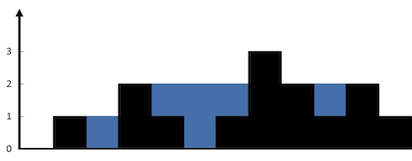Trapping Rain Water
Given n non-negative integers representing an elevation map where the width of each bar is 1, compute how much water it can trap after raining.
Example 1:

Input: height = [0,1,0,2,1,0,1,3,2,1,2,1] Output: 6 Explanation: The above elevation map (black section) is represented by array [0,1,0,2,1,0,1,3,2,1,2,1]. In this case, 6 units of rain water (blue section) are being trapped.
Example 2:
Input: height = [4,2,0,3,2,5] Output: 9
Constraints:
n == height.length1 <= n <= 2 * 1040 <= height[i] <= 105
class Solution:
def trap(self, height: List[int]) -> int:
blocks = 0
n = 0
h = float('-inf')
for hh in height:
blocks += hh
n += 1
h = max(h, hh)
total = 0
left = 0
right = n - 1
for i in range(h):
while height[left] <= i:
left += 1
while height[right] <= i:
right -= 1
total += right - left
total -= (blocks - h)
return total
Comments
Post a Comment